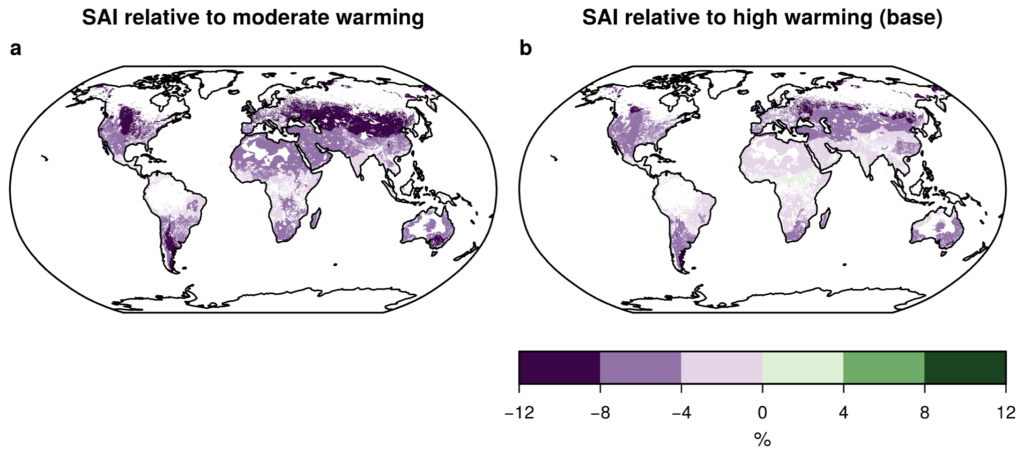Solar geoengineering has been suggested as a temporary measure to buy time for the emissions cuts needed to stabilise global temperatures.
These arguments have generally considered geoengineering as an independent component of the “toolbox” of options for climate change mitigation.
However, this perspective overlooks the knock-on effects that pursuing solar geoengineering could have on reaching net-zero.
The idea of solar geoengineering is to reduce global temperatures by reflecting more of the sun’s incoming radiation away from the Earth’s surface. One of the most talked-about approaches is stratospheric aerosol injection (SAI), which involves the injection of aerosols in an upper layer of the atmosphere.
In a pair of studies, published in Earth System Dynamics and Earth’s Future, we explore the potential impact that deploying SAI could have on the potential to generate wind and solar energy.
Our findings show that SAI could slow decarbonisation efforts by reducing the output of these energy systems. In this way, solar geoengineering could create an additional challenge to reaching net-zero, thus creating further obstacles for avoiding dangerous warming.
Buying time with temporary geoengineering
One of the criticisms of solar geoengineering is that its pursuit could obstruct or discourage ongoing and future efforts to cut emissions, sometimes referred to as mitigation deterrence. While the evidence of this is limited, what about the technological implications that could constrain efforts to reduce emissions?
To tackle this question, we have undertaken two studies into how SAI could affect the potential for solar and wind energy – key renewable sources in the transition to net-zero.
Our experiments focus on a scenario where SAI is used to bring global temperatures down from a very high-warming pathway (SSP5-8.5) that represents a failure of climate policy – to a moderate-warming pathway broadly in line with current policies (SSP2-4.5).
We compare the scenarios in the last decade of the simulations, the 2090s, where the signal of human-caused climate change is strongest.
The chart below illustrates the absolute warming levels for these pathways – showing climate model simulations for the moderate (grey lines), high (black) and SAI (red). The red bar shows the decade of interest at the end of the 21st century.
Under these pathways, end of century warming would be 2.2C lower in the SAI scenario than under high warming.
We focus on three different dimensions that help determine renewable energy potential and calculate these for each grid cell and each timestep of our simulations:
- A politico-economic dimension that assesses suitability based on land cover, regulatory restrictions and distance to population.
- The physical entity that represents the unconstrained energy resource, such as radiation, wind speed and temperature.
- The technical aspects related to conversion losses from turning energy from the sun or wind into electricity. This depends on characteristics related to solar panels or wind turbines and the density of their placement in a wind or solar farm.
These dimensions, and their interactions, are illustrated in the figure below, divided between politico-economic (green), technical (blue) and physical (purple).

Extended periods of low solar
Our results indicate that the potential for solar energy, whether compared to a moderate emissions scenario or the high emissions baseline, would be reduced in almost all parts of the world if SAI is used.
The maps below show the increase (green shading) and decrease (purple) in solar energy potential in the SAI scenario relative to the moderate (left) and high (right) warming scenarios.
We find typically larger differences under moderate warming than high warming because solar energy potential is larger in a world where global temperatures are not raised as high. Solar panel efficiency is reduced substantially in a much-warmer world.
Geographically, the largest relative reductions are in the mid-to-high latitudes. (This is due to solar geometry, which dictates that the sun’s rays arrive at a lower angle for higher latitudes, meaning they have to pass through more aerosol particles on their way to the surface.)
However, perhaps even more importantly, using SAI enhances the frequency of extended periods with low solar potential.

As the principle of SAI is to reduce incoming solar radiation, a fall in solar energy potential is to be expected.
Yet, there are actually two impacts of SAI that favour solar power: a thinning of tropical clouds, which compensates for some of the direct reduction of incoming sunlight, and lower ambient temperatures compared to the high-warming scenario, which benefit the efficiency of solar panels.
However, neither of these two impacts outweighs the overall reduction in solar power potential.
SAI may also affect how solar panels are positioned. Typically, panels are tilted to maximise the amount of direct radiation reaching the panels surface. However, under SAI, we find that radiation reaching the panels is less direct and increasingly diffuse. Therefore, tilting solar panels may become less useful.
Regional reductions in wind potential
Our findings suggest that changes in on- and offshore wind potential under SAI can be of a similar magnitude to those for solar, but whether the impact causes an increase or decrease in energy potential is highly variable depending on the location and season.
Overall, these changes lead to a negligible global impact on wind potential, but the regional charges can still be significant – with particular reductions in China and central Asia, along with Mexico, western US and many parts of the southern hemisphere.
This is shown in the maps below, which illustrate the increase (green) and decrease (purple) in offshore wind energy potential in the SAI scenario relative to the moderate (left) and high (right) warming scenarios.

The changes in wind potential under SAI are caused by changes in large-scale atmospheric circulation – mainly a result of the heat absorbed by the injected aerosols.
The impact on wind potential is more nuanced than for solar. For example, there is a general long-term slowing of surface winds under SAI. (This has also been observed in simulations using a different climate model from the one used in our study.)
However, due to the delicate range of wind speeds where wind turbines operate, slower winds can actually lead to either an increase or a decrease in potential.
Of course, changes in wind energy potential are only realised if the areas are actually exploited for wind energy. However, the large regional changes in wind potential may imply that a different strategy would be needed for siting windfarms in order to maximise the energy produced. However, this would cause problems later down the line if SAI is intended as a temporary measure.
Implications for decarbonisation
With a reduced potential for wind and solar when using SAI, there is a risk that deploying SAI would actually lead to a slowing of decarbonisation.
This, in turn, implies that solar geoengineering would need to be deployed for even longer – unless the gap could be met with higher amounts of carbon dioxide removal. Other research has found that, once started, geoengineering would be required for multiple centuries.
Such knock-on impacts put the concept of using geoengineering to “buy time” for climate change mitigation into question.
In fact, because of the reduced output of renewables under SAI, relatively more renewable capacity would need to be installed just to produce the same amount of energy as without SAI.
At the same time, renewable technology may also need to be adapted to SAI circulation and radiation conditions for optimal energy production. This could include adjusting the tilt of solar panels and adapting windfarm placement strategy and wind turbine characteristics.
The substantial impact geoengineering could have on mitigation – and vice versa – highlights the importance of considering such couplings when moving towards more comprehensive assessments of climate geoengineering.
Baur, S. et al. (2024) Solar radiation modification challenges decarbonisation with renewable solar energy, Earth System Dynamics, doi:10.5194/esd-15-307-2024
Baur, S. et al. (2024) Change in wind renewable energy potential under stratospheric aerosol injections, Earth’s Future, doi:10.1029/2024EF004575
Sharelines from this story


